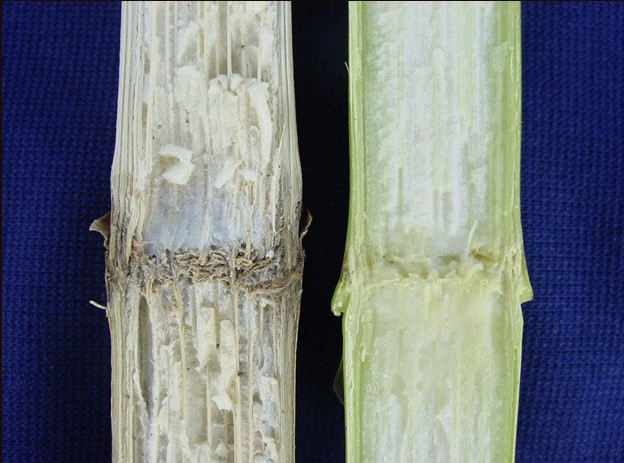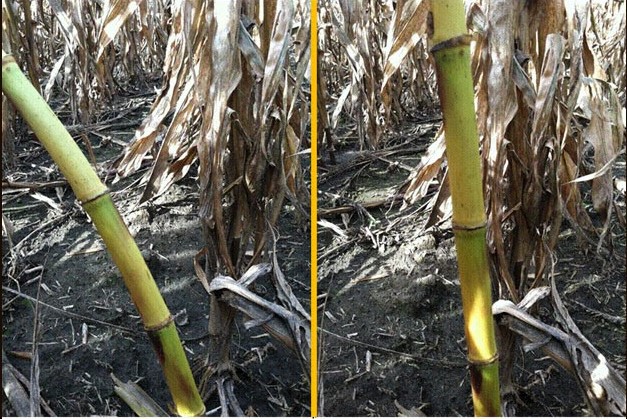
Sep 15, 2017, 8:30 AM
Pre-Harvest Corn Tests
As we near harvest, it’s important to start determining your order of harvest for fields. This is determined by two key factors: plant health and moisture percentages. The combination of the two sets of information will help you plan a harvest order for your operation.
Plant Health
Use these three tests to determine if there is any weakness in the corn stalk that might cause it to lodge late in the season. Each test should be done on about 20 plants randomly throughout each field.
Split Test: Split open the stalk to look for signs of stalk rot. In Figure 1, the stalk on the left shows signs of weakness from rotting, while the stalk on the right is strong and healthy.

Figure 1
Push Test: Hold the corn plan right below the ear and push it over until the stalk is at about a 45° angle. See the image on the left in Figure 2. Let go of the stalk. If it stands back up, the plant is healthy like the image on the right.

Figure 2
Pinch Test: Place your fingers about eight inches above the ground and try to pinch the stalk together. If you cannot easily compress the stalk together, the plant is healthy. Figure 3 shows an unhealthy stalk that is easily pinched.

Figure 3
Moisture
As with most things, optimal harvest moisture percentage is a matter of opinion and personal preference. Most farmers begin harvesting when their corn is below 20-25% moisture. As the corn plant continues to dry down closer to 15%, the yield loss from the header or dropped ears becomes greater and greater – arguably more than the cost of drying. To test the moisture of your corn, collect a sample and use a home moisture tester. Confirm that your tester is properly calibrated by comparing to your local elevator. Legend Seeds Sales Agronomists use a DICKEY-john, mini GAC plus®.
Pre-Harvest Corn Yield Estimation
- Determine your harvestable population by measuring 1/1000 of an acre. Utilize the row width that the field was planted in according to Chart 1.
- Measure out the distance determined from Chart 1. Count the number of ears present in that distance. Randomly select and hand shell that number of ears from the field.
- Hand shell and weigh that corn on a simple home scale in a 5-gallon plastic bucket. Subtract the weight of the bucket.
- Test the moisture with a grain moisture tester.
- Take 100 – moisture x weight x .2113 = estimated yield per acre.
|
Chart 1: Row Width (inches) |
Length for 1/1000th Acre (feet, inches) |
|
7 |
74’ 10” |
|
15 |
34’ 10” |
|
20 |
26’ 1” |
|
22 |
23’ 10” |
|
30 |
17’ 5” |
|
36 |
14’ 6” |
|
38 |
13’ 10” |
|
40 |
13’ 1” |
|
Purdue Extension Corn & Soybean Field Guide |
Yield Estimation Example
As an example, we’ve completed the calculation for a field planted with thirty inch rows. The information collected in each step is listed in bold.
- Determine your harvestable population by measuring 1/1000 of an acre. Utilize the row width that the field was planted in according to Chart 1. 30’’ rows = 17’ 5’’
- Measure out the distance determined from Chart 1. Count the number of ears present in that distance. Randomly select and hand shell that number of ears from the field. 32 ears
- Hand shell and weigh that corn on a simple home scale in a 5-gallon plastic bucket. Subtract the weight of the bucket. 12 pounds
- Test the moisture with a grain moisture tester. 20 percent
- 100 – 20 x 12 x .2113 = 202.8 bushels estimated yield
Summary
Each year brings new weather, new challenges and different harvest circumstances. Utilize a combination of the information collected from the stalk strength tests and moisture percentage to determine your harvest order this year. Prioritize the fields with the unhealthy stalks and lower percentages over the healthy fields with higher moisture percentages.

